PinotFile: 7.13 February 25, 2009
|
Rhys Vineyards: Staking Out Terroir in the Santa Cruz MountainsIt all started rather innocently for Kevin Harvey. Sampling wine on his honeymoon in France piqued his interest. A 1990 Gary Farrell Russian River Valley Pinot Noir brought him to attention and inspired his exploration of Pinot Noir and its many growing regions. It wasn’t long before he became hopelessly hooked on Pinot Noir and dabbled in both New World Pinot Noir and Burgundy. In 1995, Harvey planted a small Pinot Noir vineyard in the backyard of his home in Woodside, located in the hills above Stanford University. He began crafting small amounts of wine in his garage. Visions of owning a winery in Sonoma County one day occupied his thoughts but the Pinot Noirs from the Santa Cruz Mountains soon began to attract most of his attention. There was something about the earthiness and minerality of Santa Cruz Mountain Pinot Noirs that held a magical appeal for him. Tasting older vintages of Mt. Eden and Santa Cruz Mountains Vineyards Pinot Noir convinced him that it was the earthy minerality and tannin of these wines that led to their age ability. In addition, he found the wines developed more interest over time, becoming “amazing with age.” Harvey confessed, “Many California Pinot Noirs were too sweet for my taste. Minerality and tannins provide a relief to the fruit and a drier finish.” He would go on to conclude, “The Santa Cruz Mountains are the most mineral-driven wines in the New World.”
Minerality is a controversial term to say the least. The central scientific issue is whether minerals in vineyard soils can really travel up the roots and xylem into the grapes and survive fermentation in large enough concentrations to produce identifiable mineral flavors and aromas (for example, flint or slate). Knowledgeable wine people cannot agree whether this happens. Noted viticulturist, Dr. Richard Smart, for example, points out that there is no scientific evidence to support a link between the mineral composition of vineyard soil and the aromas or tastes of wines. Tim Patterson approached the subject in an article in Wines & Vines (“Myths of Minerality,” December 2006) in which he reviewed the limited research on the minerality of wine and offered his own opinions on its origins. He points out that there is no “mineral” on the Wine Aroma Wheel and the creator of the wheel, Dr. Ann Noble, feels that, “Minerality is a concept which could never be consistently defined in words or physical standards.” University of California Davis flavor chemist, Dr. Sue Ebeler said, “There are no clear correlations of any specific compounds which we associate with the smell of soils or rocky area.” Patterson points out that minerals such as potassium, magnesium, sodium and calcium are present in wine as salts of mineral acids, but are in such small concentrations they do not significantly influence wine flavors and aromas. Trace amounts of other minerals such as zinc, copper, nickel, and lead are also present in wine. Jamie Goode has pointed out (The Science of Wine ,2005) that so called minerality in wine can originate from acidity and sulfur-based compounds that develop in the winemaking process. Support for this theory comes from Germany where high acid in the wines and reductive winemaking creates wines that are acidic and highly mineral in nature. Noted winemaker, Randall Grahm, is an outspoken proponent of minerality and terroir. “It is my personal belief that wines that are richer in minerals just present way differently. I believe that generally in mineral-rich wines there is a suppression of obvious fruit......they seem to have a sort of nucleus or density around their ether, they are gathered, focused, cohered the way a laser coheres light.” Harvey is adamant that the current scientific understanding of minerality (he prefers the term “site expression”) is woefully inadequate and dangerously misleading. He told me, “Wine is just too complex and the incentives are too small to justify the type of research that is necessary to fully understand the interplay of soil and wine. Current science places too much emphasis and faith on an incomplete (and probably inaccurate) understanding while the everyday reality of “minerality” can be best experienced through a glass of wine! The lack of scientific understanding has led to a de-emphasis of the idea of terroir in the New World which has greatly slowed the discovery of great wine outside of France.” Harvey continues, “Whether it is the scorched earth of Haut Brion, the Asian spice of La Tache, the rusty iron of a wine from Nuits St. Georges, the seashells of Chablis, etc., site-derived attributes are what make wine endlessly fascinating and not just a simple fruit drink. Distinctive site expression (of which “minerality” is a subset) is what causes all the world’s greatest wines to rise above the pack. It is the key to real, lasting complexity and interest and it is what causes wine to improve and become more complex with bottle age as opposed to just mellowing.” Pleading his case, Harvey says, “It is my belief that the mineral and nutrient composition of soil (and resulting specific resident biology) and the physical properties of the soil combine to create unique site expression in wine. I hope science can one day explain all of this, but as long as science is still asking, ‘What is minerality?’, we have a long, long way to go.” Harvey is convinced that site expression or “somewhereness,” differentiates all the great wines of the world. Their distinctiveness reflects the terroir from which they originate. When he began to study the geological maps and the composition of the earth of the Santa Cruz Mountains, he discovered more geological diversity than in Burgundy and Sonoma. Burgundy soils are all a variation of limestone and Sonoma soils are also rather homogeneous with most areas where Pinot Noir is grown possessing Goldridge soil (with some variation as one nears the Pacific Ocean), while the soils of the Santa Cruz Mountains range vary from limestone to shale to clay to sandstone. He also looked at climate as an important part of terroir but he has come to believe that soil plays a bigger role in terroir than climate. As he notes, “Soil is underrated in California.” Harvey had done his homework and in 2001 he embarked on an ambitious project to produce site-specific wines from carefully chosen and distinctive terroirs in the Santa Cruz Mountains. To reach his goal, he established several limits in his vineyards and in the winery all directed at maximizing vineyard expression. Vineyards: (1) Every vineyard had to have a distinctly different soil and geology; (2) The vineyards had to be natural, balanced and alive, not groomed; (3) The vineyards would be farmed organically and biodynamically insuring that the resultant biodiversity would contribute to site expression. Ground cover crops including herbs, flowers and vegetables would be encouraged and cover crop and weeds would be managed with mowing, spading and hand hoeing with no use of Roundup permitted. Free-range chickens and sheep would be used for weed control and fertilization. Spraying would be limited to sulfur and organic oil; (4) Complete control of harvesting so picking would be possible over several days or weeks as the vintage would dictate; (5) Vineyard sites would be chosen that had never been forested to avoid soils that exhibited too much clay and acidity (the exception is Family Farm Vineyard - see below); (6) Emphasis on clonal diversity in each vineyard using primarily heritage rather than Dijon clones and mixed mass selection (selection massale ) plantings (cuttings from many different vines). Harvey believes the best wines are made from genetically diverse vines and that certain clones developed for their color and personality can dominate the soil expression of the wines; (7) Rocky soils are preferred for vineyard site selection. Harvey notes that most of the great wines of the world are grown on rocky soils; (8) Minimal leaf pulling. Harvey maintains that this addictive practice is overused and is often done primarily to facilitate spraying onto the grapes; (9) Each vineyard site will have a significant portion of the land left to its natural state. Winemaking (1) Winemaking would be identical for each vineyard so that the resultant wine would be a pure expression of each vineyard unencumbered by winemaking variables; (2) Winemaking would be strictly natural with no manipulation and no amelioration with added enzymes, tannins, water, or yeast. On occasion, a small amount of acid has been added to some wines; (3) Strict adherence (no lip service) to the idea that the wine is made in the vineyard; (4) No attempt to produce the same wine with each vintage; (5) Eliminate barrel variability in the winemaking program by using the same cooperage source every year. Four year air dried oak barrels are chosen to elevate the fruit and tannin of the wines without imparting oak flavors; (6) Whole cluster fermentations. Harvey conferred the name Rhys Vineyards on his project, using a family name, the Welsh spelling of Reese. He planted four vineyards from 2001 to 2005, most within eight miles of the Pacific Ocean and all within a 25 minute drive of each other. Family Farm Vineyard (and Home Vineyard which was planted in 1995) are located on the eastern foothills of the Santa Cruz Mountains but since they are about 200 feet below the demarcation of the official Santa Cruz Mountains AVA, they are not strictly within the AVA. Despite this incongruity, the wines from these two vineyards are Santa Cruz Mountains in character. The location of five of the Rhys vineyards is depicted on the Google map on page 3. A sixth unnamed vineyard consists of 20 acres in the cool “deep” end of the Anderson Valley adjacent Kiser Vineyard. The vineyard is planted in shale and Harvey notes that early wine from this site has “crunchy red fruit, a wet tin can smell and considerable minerality.” Home Vineyard is an east facing site of 1 2/3 acres planted to Pinot Noir. Family Farm Vineyard is 6.2 acres of Pinot Noir located on an east facing slope at the site of a previous Christmas tree farm. This is the only vineyard not owned by Rhys, currently being leased from Stanford University. Both Home Vineyard and Family Farm Vineyard can be located on the Google map just above Sky Londa. Alpine Road Vineyard is an ocean facing site that sits at 1,200 to 1,500 feet above sea level. 11 acres of Pinot Noir and 12/3 acres of Chardonnay are planted here on rocky soils that were never forested. Horseshoe Ranch Vineyard, which is just a few hundred yards away from Alpine Road Vineyard, faces east. It is the largest of the Rhys Vineyards at 17 acres (10 acres of Pinot Noir, 4 1/4 acres of Chardonnay, 3 1/2 acres of Syrah and 1 acre of Nebbiolo). Skyline Vineyard is the highest site at 2,360 feet planted unusually dense on almost pure rock. It consists of 2 1/2 acres of Pinot Noir and 1 acre of Syrah. Skyline Vineyard is located on Skyline Blvd. (Highway 35). The total is 42 acres, making Rhys Vineyards one of the top three vineyard holdings in the Santa Cruz Mountains.
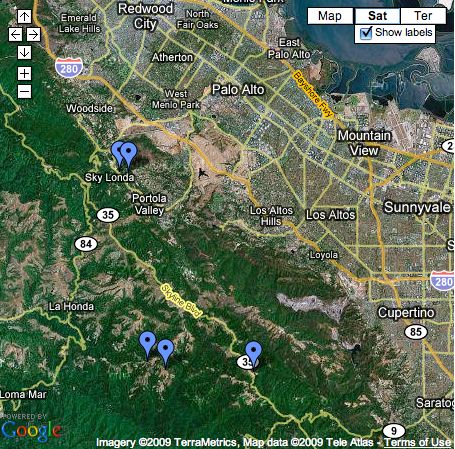 Harvey has carefully studied the climatic conditions of his vineyard sites and found that they compare favorably with other cool climate growing regions of the world. The graph below shows the average monthly mean temperature which regulates a vine’s metabolism. Burgundy is compared to four of the Rhys vineyards. Average monthly mean temperature is the most important measure when considering the suitability of Pinot Noir for a given site. (A clarification is in order here. Climate refers to long-term averages while weather describes the day-to-day alterations in those averages. As noted in The Art and Science of Wine, “Weather may make or break a vintage, and may explain the particular characteristics of a given wine, but it is climate that determines which grapes will grow and ripen well in any given locality.”) Vineyard sites based on terroir and not on yields. Many New World vineyard sites are developed that are too vigorous to produce great wine. Harvey jokes about his Alpine Road Vineyard, “We have a delusion that one day this vineyard will set a normal Pinot Noir crop.” The cost of developing this vineyard has exceeded all of his expectations but he has stuck to his guns and the wines have rewarded his dedication.
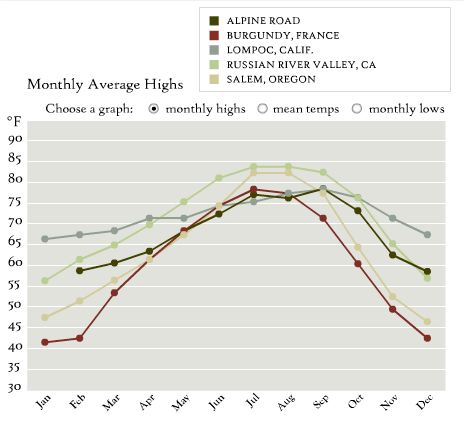 The next graph compares Alpine Road Vineyard with four other major Pinot Noir winegrowing regions of the world.
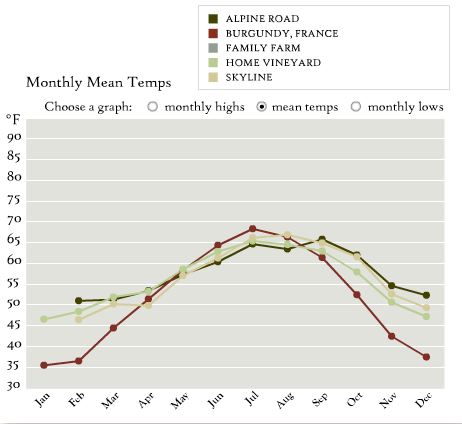 Harvey has come to believe that the primacy of soil takes precedent over climate as a contributor to differences of site expression and minerality in the wines of Rhys Vineyards. The first three vintages (the 2005 crop was devastated by frost and little wine was produced) have confirmed his belief. Climate does matter, but much less than is commonly believed. He found temperature differences between separate blocks within a vineyard can be quite large and in some cases greater than the generalized climatic differences between the vineyards themselves, yet the blocks still exhibited the same identifiable wine character (minerality) when they were on the same soil type. Harvey is also a proponent of biological diversity and considers it a key to soil expression in wine. It is well known that grapevines expend up to 40% of their energy hosting the symbiotic microbes that break down soil and provide nutrients to the vine’s root system. This complex relationship may create the organic molecules that exist in a finished wine. Harvey notes, “While soil clearly contains specific minerals and nutrients, it also contains bacteria and yeast that are specific to soil types. Water availability (which is driven by physical properties) in the soil is known to affect the nature of tannins in wine and I think that tannin character is a key component of unique site expression as well.” Spoken by a true “terroiriste.”
Terroir has been defined by Jamie Goode as “Possession by a wine of a sense of place or “somewhereness.” In other words, “A wine from a particular patch of ground expresses characteristics related to the physical environment in which the grapes are grown.” Wine from a single place produced by a single estate is the greatest expression of winemaking. Other uses of the word terroir include the description of a vineyard itself and the phrase goût de terroir, which translates as “a wine tastes of terroir.” Terroir is one of the few wine terms the French are willing to share, presumably because there is no English equivalent and they have been able to make a ton of money off of it. Many factors contribute to vineyard terroir including soil type (its physical, chemical and biological make-up), climate, slope gradient and orientation of the site. Some would also include methods of harvesting and even the human element of winemaking but most wine cognoscenti do not consider these factors in terroir. There is no question, however, that bad winemaking can obscure terroir. Great vineyard terroir is a valuable commodity since there is such little of it. As Clive Coates has remarked, “There are limited places in the world where the right choice of grape complements great terroir and can produce great wine.” There are many advocates of terroir in the New World, many of which have spent considerable time in France. Wine critic, Matt Kramer, is outspoken on terroir. He says, “A surprising number of winegrowers and wine drinkers - at least in the United States - flatly deny the existence of terroir, like weekend sailors who reject as preposterous that Polynesians could have crossed the Pacific navigating only by sun, stars, wind, smell and taste. Terroir is held to be little more than viticultural voodoo.” Ted Lemon, of Littorai, pleads his case: “I believe soil is important in determining a wine's character. It's clear there are tremendous differences between wine made from vineyards right next to each other even if they are vinified and treated exactly the same way.” I was fortunate to spend some time recently with Kevin Harvey, his winemaker, Jeff Brinkman, and his viticulturist, Javier Tapia Meza. Harvey is a Texan who studied Electrical Engineering at Rice University, graduating in 1987. He founded Styleware and pioneered integrated software for Apple II personal computer programs for the Mac. He then became the Founder, President and CEO of Approach Software which led to the development of the world’s first end-use client-server database for Windows. Currently, he is a General Partner in Benchmark Capital, a team-based provider of venture capital for technology. Meza is a third generation winegrower from Chile who is an expert in the field of organic and biodynamic winegrowing. Brinkman is a bright, young winemaker who majored in biochemistry in college, sold wine for a short time at the retail level, and then learned winemaking on the job, beginning as a cellar rat in 1996. He is enamored with the opportunity to make wine at Rhys Vineyards and remarks, “This is one of those places you dream about working at and making wine. It’s an ideal place.” Below at Alpine Road Vineyard, L to R, Harvey, Brinkman and Meza.
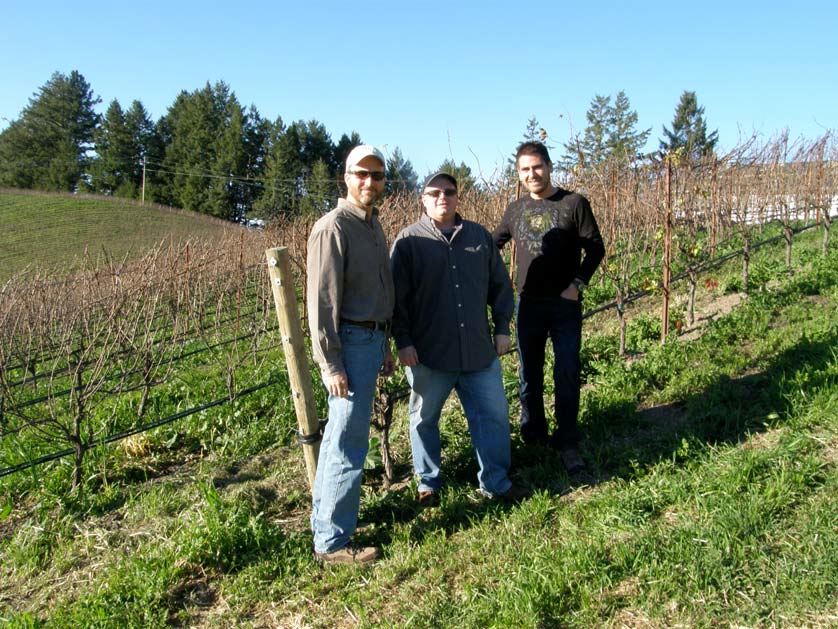 On a sunny afternoon, we drove through the isolated hills of the Santa Cruz Mountains spending time at each vineyard, talking about site expression, walking the rows of vines and kicking dirt. At the end of the day we gathered at the winery’s tasting room located adjacent the new winery which is under construction. The winery, which is located within 5 miles of each Santa Cruz Mountains Rhys vineyard, will be outfitted in a very large cave dug out underneath Skyline Vineyard. The winery is projected to be completed in 2010 and will have the capacity to produce 10,000 cases annually. For bearings, note that Ridge Vineyards is located 3 miles to the east of Skyline Vineyard. The wines are currently produced in a modern facility in nearby San Carlos. In the following pages, I have presented a summary of each vineyard in the order we visited them (excepting Home Vineyard which I did not visit but which will be discussed first) along with photographs of the vineyard sites. I have also included my tasting impressions of the 2007 vintage wines for each vineyard (final blends from barrel) and two 2006 vintage wines that I tasted at home before my visit. The wines produced by Rhys Vineyards under the Alesia label from purchased grapes are reviewed at the end of this feature. The 2004 vintage was the first commercial release of Rhys Vineyards wines and the 2007 vintage was the first year that wines were produced from each of the five vineyards. In 2005, unstable weather during flowering wiped out most of Rhys estate production and production of Alesia wines was reduced as well. 2006 brought some of the highest yields to date and 2007 saw production reduced by 40%. By 2009, all Rhys Vineyards wines will be made exclusively from estate fruit. Before setting out on the vineyard tour, a few words about winemaking at Rhys Vineyards are relevant. When I asked Brinkman about his winemaking regimen, he made it clear that the wines at Rhys were made in the vineyard. He remarked that many people unfairly lay claim to making wine in the vineyard. “If I say the wines are made in the vineyard, it means I am able to take the grapes as they come in and allow the wines to be made as they are. On the other hand, if someone says that this is the fruit and this is what we have to do to fix it, then they are not making wine in the vineyard.” All the wines are crafted in an identical manner. The grapes are hand picked into half-ton containers. Because the vines are extremely balanced, picking occurs at 21.5º to 23º Brix. Harvey notes, “Peoples’ eyes pop out when we tell them that we get ripe fruit at this Brix.” All the Rhys Vineyards estate wines are 14.0% alcohol or less. In 2007, all the estate wines were between 12.0 and 13.5% alcohol! The grapes are picked over a several day interval without a concern about achieving the same ripeness in every vine row. Harvey remarks, “Californians are obsessed with uniform ripeness, yet a variety of ripeness makes a more interesting wine.” The grapes are carefully hand sorted, picking out any shrivels (“We don’t want to make wine from raisins!”), and placed 100% whole cluster into 1-ton fermentation tanks. Each of the estate vineyards is organized around half-acre blocks. These small parcels are picked and fermented separately. Fermentation in small lots from specific vineyard blocks gives Brinkman more than 80 ferments from which to compose his blends. Specific barrels can then be chosen for the vineyard designated blend to achieve balance and completeness without needing to modify or inhibit the vineyard’s natural expression. Also, micro-vinifying small parcels allows for the identification of some of the most special and unique locations within the vineyard. In 2006, this effort resulted in three different Pinot Noirs from the Alpine Vineyard, each offering a different facet of the vineyard. The grapes undergo a 10 to 14 day cold soak under sealed conditions. The cooling jackets are then turned off and natural fermentation is allowed to continue (no proprietary yeasts or additives are used). The cap is punched down three times a day by foot treading, a method chosen for its gentleness. Fermentation lasts about 3 weeks. At less than 5º Brix, the ferment is sealed up and pressed off with a basket press and the juice gravity fed into barrel. MLF is allowed to continue on its own. Blending takes place either before or after the next harvest after the wine spends approximately 14 months in barrel. All barrels are sourced from Francois Freres and made from 4-year air-dried staves. This eliminates any barrel variability effect on the finished wines. There is no recipe for the percentage of new oak, which varies from 25% to 75%. The exact amount is constantly being refined. The estate wines are all unfined and unfiltered. The whole process is natural and straight forward and hearkens back to the days in Burgundy when wine really was made in the vineyard.
Location: Eastern foothills of the Santa Cruz Mountains. Strictly speaking, not in the official Santa Cruz
Mountains AVA. 450’-500’ of elevation.
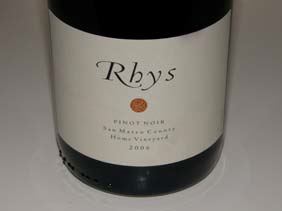 2006 Rhys Vineyards Home Vineyard San Mateo County Pinot Noir 13.3% alc., $59. · Marvelous Pinot scents of dark red cherries, roses and a touch of butterscotch. Highly unique flavors of exotically spiced dark red stone fruits and fraise de bois with a complimentary hint of oak. A wine of great finesse, very smooth in texture, with gossamer dry tannins and a lengthy, scented aftertaste. Still drank beautifully the next day from an opened and re-corked bottle (I polished it off).
2007 Rhys Vineyard Home Vineyard San Mateo County Pinot Noir 13.3% alc., $59. 100% new oak. · Very complex and promiscuous scents of cherry syrup, raisin, brambly underbrush, warm croissant and even gingerbread. An appealing earthiness underlies the fruit which is rich and full on the palate and encased in gentle dry tannins.
Location: 200 yards from Home Vineyard in the eastern foothills of the Santa Cruz Mountains. Northeastern
exposure. Gently sloping and not on a hillside. The least scenic of the Rhys Vineyards, but very “Russian
Riveresque” with similar sandy clay loam soils and aspect, reminding Harvey of Rochioli Vineyard in the
Russian River Valley. On the site of a former Christmas tree farm. Leased from Stanford University (the only
Rhys Vineyard not owned by Harvey). 400’ of elevation.
2007 Rhys Vineyards Family Farm Vineyard San Mateo County Pinot Noir 13.3% alc., $49. Aged in 40% new French oak barrels. · Loamy bright berry fruit accented with spice and chocolate. Tasty core of dark raspberry and strawberry fruits combined with a silky texture and a refreshing tang on the finish. Beautifully composed and harmonious.
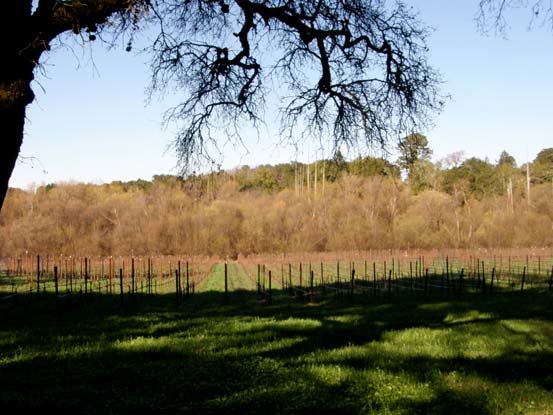 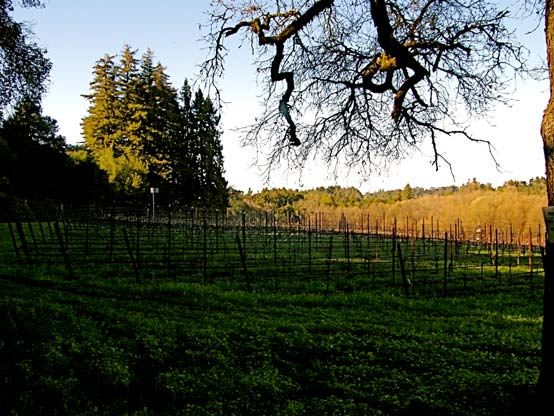
Location: Primarily south-facing steep hillside vineyard with some east and west exposures and slopes that
can range up to 40%. 8 miles from the Pacific Ocean and 3.6 miles west of Skyline Blvd. One portion of the
vineyard is east facing and terraced into rock, the so-called Swan Terrace. 1,200’-1,490’ of elevation.
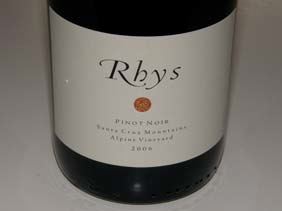 2006 Rhys Vineyards Alpine Road Vineyard Santa Cruz Mountains Pinot Noir 14.0% alc., $49. · Deep reddish-purple color and a deeply charmed wine. Taunting aroma of black raspberry jam. Delicious compote of brambly dark and blue berries that is mouth filling, yet majestically toned. There were other flavors that defied description. The tannins were mild, dry and fine-grained, there was notable absence of oak, and the wine had impeccable balance. Still drank beautifully the next day from an opened, re-corked bottle. This is a wine that stirs emotion.
2007 Rhys Vineyards Alpine Road Vineyard Santa Cruz Mountains Pinot Noir 13.0% alc., 450 cases. · Very showy scents of dark berries, root beer, herbs and roses. Vibrant fruitiness in the mouth with remarkable roundness and intensity considering the alcohol level. Very soft tannins make this wine easily approachable now.
2007 Rhys Vineyards Alpine Road Vineyard Swan Terrace Santa Cruz Mountains Pinot Noir 13.3% alc., 150 cases, $59. · This wine outshines the other two Rhys Alpine Road Vineyard Pinot Noirs which are very stellar in their own right. It just sucks the air out of you, leaving you speechless. I had very few notes written down on this one other than a star because all I could do was shake my head and smile. The demure dark stone and berry fruits laced with anise and musk grab you and draw you in. The wine is a revelation, exceeding the bounds of description.
2007 Rhys Vineyards Alpine Road Vineyard Hillside Santa Cruz Mountains Pinot Noir 12.9% alc., 100 cases, $49. · Very dark reddish-purple hue (the Dark Knight in the lineup). On the nose there are bright fresh berries and wet rocks. Generous amounts of ripe Pinot fruits, especially black raspberry, with a base of minerals and earth that fan out nicely on the palate. Still restrained and seductive, hiding behind a healthy structure of ripe, firm tannins. A distinctive wine of great charisma that needs some time to fully reveal itself.
2007 Rhys Vineyards Alpine Road Vineyard Santa Cruz Mountains Chardonnay 13.7% alc.. Left on the lees until bottling. Unfined and unfiltered. · Chalky minerality runs through this superb wine. Accents of smoky oak, pear and citrus add interest. There is a lingering taste of lemon meringue pie on the finish which offers a refreshing grip of acid.
The photo below shoes the Hillside portion of the Alpine Road Vineyard in the foreground and the Swan Terrace in the distance. The Ranch Systems weather station shown in the bottom right photo collects vineyard information including temperature, relative humidity, ultraviolet radiation, wind and precipitation and relays the information by wireless data transmission.
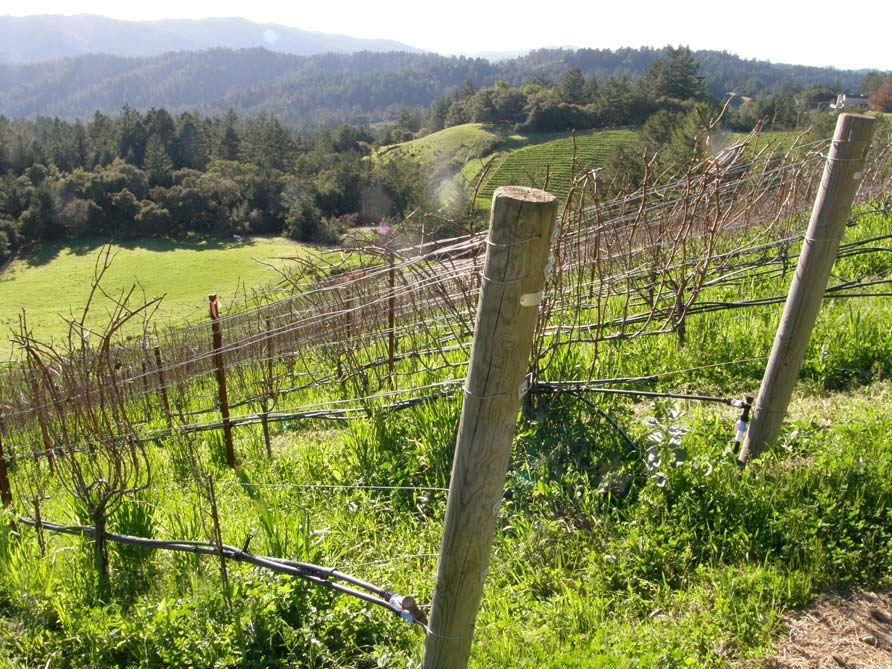
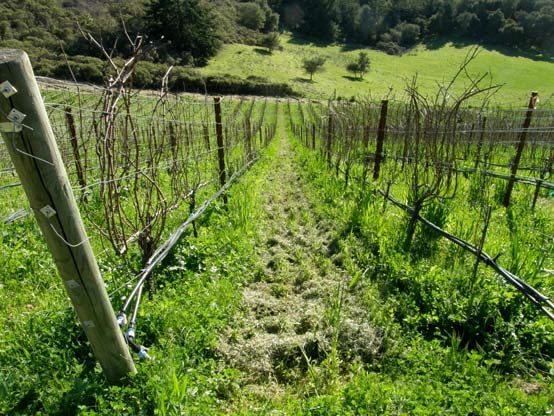 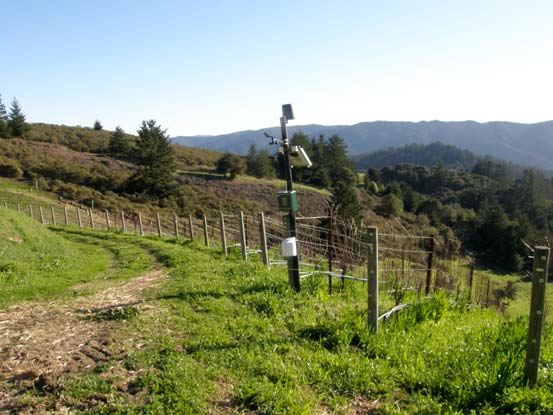
Location: A picturesque site located less than one-half mile from Alpine Vineyard. A ridge between the two
vineyards leaves Horseshoe more protected from maritime influences. 1,360’-1,610’ of elevation.
2007 Rhys Vineyards Horseshoe Ranch Vineyard Santa Cruz Mountains Pinot Noir 12.3% alc., $49. · This wine smells remarkably of damp earth. In the mouth, there are saucy blueberry and cherry fruits surrounded by healthy tannins. The winemaker said he could taste shale in the wine, something I could not confirm because of my limited experience in shale tasting. Heck, I could dig (sic) it and I could tell it was a wine that was clean, pure and pristine with an appealing suave texture.
2007 Rhys Vineyards Horseshoe Ranch Vineyard Santa Cruz Mountains Chardonnay 13.3% alc.. One barrel this vintage. 100% MLF. · Compared to the Alpine Ranch Chardonnay, this was more fruity and floral while demonstrating less acidity. It was very luscious showing off some tasty brioche, butter, pear and lemon notes.
The photo below left shows the horseshoe-shaped layout of the vineyard. Sheep were grazing the day I visited. The rocky soil is evident and the vineyard is alive and thriving and not groomed.
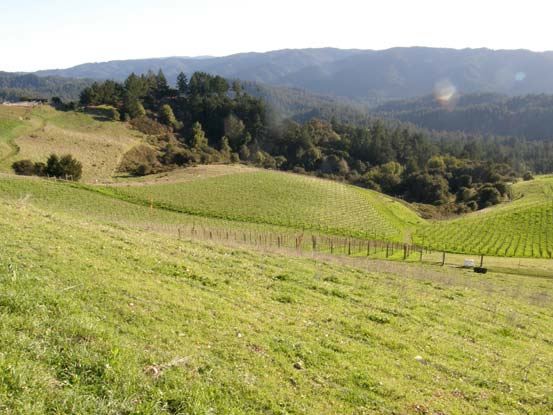 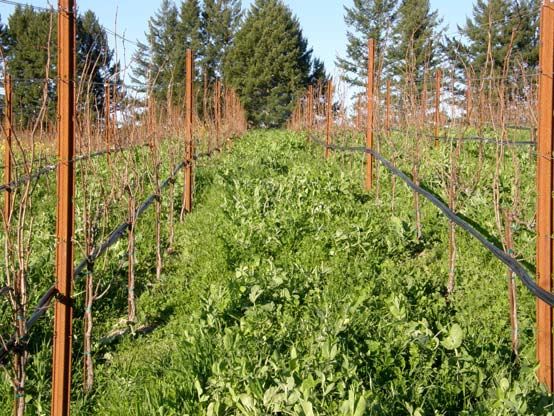  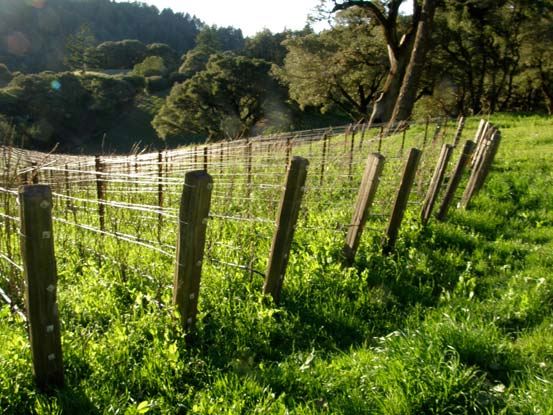
Location: One of the highest vineyards in California at 2,270 to 2,360 feet of elevation. The location provides
for constant sunshine above the fog line yet the high altitude crates a very cool climate.
2007 Rhys Vineyards Skyline Vineyard Santa Cruz Mountains Pinot Noir 13.0% alc., $49. Yield 0.54 tons per acre. 50% new French oak barrels. · A very unique and challenging wine with exotically spiced black cherries and berries on the nose which carry over onto the palate with added brioche, grape and a hint of citrus. Prominent raspberry flavors explode and saturate the palate. An extremely intriguing spice box component is quite unique. A sensual and harmonious wine that still has some ripe tannins to shed.
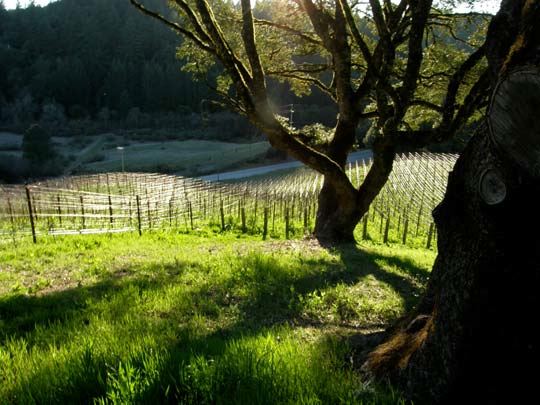 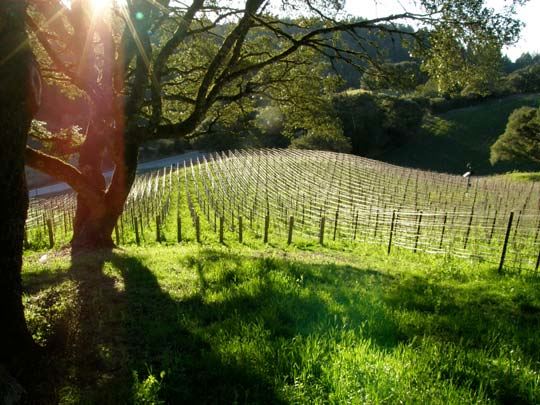 Other wines I tasted are crafted from purchased grapes and are labeled “Alesia.” The 2006 vintage Alesia wines were sampled at home.
2007 Alesia Sonoma Coast Pinot Noir A blend of several vineyards. · Showy and vibrant aromatics featuring black cherries and raspberries echoed in the flavors with good flavor persistence on the finish marked by lively acidity.
2007 Alesia Green Valley Pinot Noir A very pretty wine with the marvelous smell of a fresh cherry pie. Silky and vibrant with refined tannins and a citrus tang on the brisk finish.
2007 Alesia Falstaff Road Sonoma Coast Pinot Noir This vineyard is located adjacent Benovia Winery planted in sandy Goldridge soils and impeccably farmed by owners Ron and Judy Lougheed. · Saddle up for this big boned wine. Very dark reddish-purple in color. When you pour it, you know you are in for a ride. Complex nose of dark stone fruits, hi-country forest and cardamon spice. Luscious dark fruit liqueur that is rich and plush on the mid palate with uncommonly long persistence. Olallieberry fruit stands out. Seriously fruity and definitely Caliesque but not jammy in the least with impeccable balance.
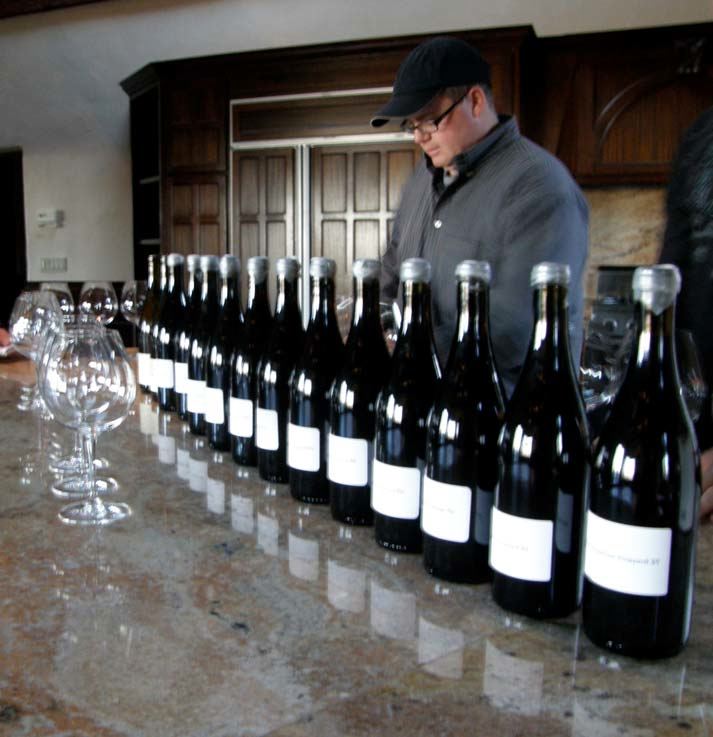
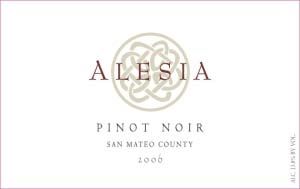 2006 Alesia San Mateo County Pinot Noir 13.8% alc., $29. Made from declassified wine from Family Farm Vineyard. · Lovely aromas of crushed cherries, spice, herbs with a roseate lift. Sweet cherries and raspberries are kissed by earth and savory herbs. Light in weight with a soft mouthfeel and very soft tannins. A perfect wine for daily drinking now.
2006 Alesia Green Valley Pinot Noir 14.2% alc., $44. Primarily from the 2-acre Layton Family Vineyard organically managed and planted to heritage clones. · Decent aromatic profile of red berry jam, oak, herbs and a hint of mint. Bright red cherry and cranberry flavors with a touch of oak and herbs, moderate tannins, crisp acidity all brought together in an elegant fashion.
Kevin Harvey has done everything imaginable within his power to maximize vineyard site expression in the Santa Cruz Mountains. One cannot help be impressed by his steadfast beliefs and his drive to produce the most terroir-driven wines in the New World. He is not giving lip service to his ideas, but rather striving by all his means to implement them. After meeting and talking with him and tasting his wines, I was reminded of a quote by winemaker Chris Carlberg, who hails from the Willamette Valley, “We need to learn the difference between living purposefully and merely existing by taking the time to sharpen our awareness and figuring out how to do things in the right way for the right reasons.” When I tasted the lineup of Rhys Vineyard Pinot Noirs and Chardonnays from the 2007 vintage, I was left rather speechless. The wines were stunning and all distinctive. They were balanced and harmonious and spoke of a unique place unencumbered by excessive alcohol, oak, and overripe or over-extracted fruit. They were simply some of the most remarkable New World Pinot Noirs I had ever experienced. Harvey reminds me in many ways of a winegrower who I greatly admire, Ted Lemon, of Littorai, located in Sebastopol, California. Their philosophies are remarkably alike. According to Ted, “The future of West Coast Pinot Noir, and indeed all West Coast wines, lies in learning to work with our soils so that we can produce full, ripe and profound flavors at lower Brix levels, Brix levels which will naturally give us wonderful wines in the 12% to 14% alcohol range. Mother nature does this occasionally on her own. Too often in California, winemakers pick fruit at absurdly high Brix levels, claiming that is the genius or forte of California terroir. For all wine producing regions, there is a middle ground of striving to produce fully mature fruit which reflects the terroir in which it is grown. Fruit picked at perfect balance will always be the most crystalline reflection of the terroir in which it is born.” Two men with completely different backgrounds led to reach the same conclusions and we wine lovers are much the better for it.
If you want to give yourself a stimulus package, I would recommend signing up for the Rhys Vineyards mailing
list. The wines are highly allocated (based on cumulative buying history) and only sold through the mailing list.
Join the mailing list and you will be thanking me for years to come. The website is www.rhysvineyards.com.
As I mentioned previously, the yields were down in 2007, roughly half of 2006 levels, but future vintages should
result in more wine as the vineyards develop maturity and replanting efforts bring vines on line. The winery is
not currently open for tasting or tours. Click here to listen to an interview with Kevin Harvey, in two parts: “Kevin Harvey Interview Part 1”
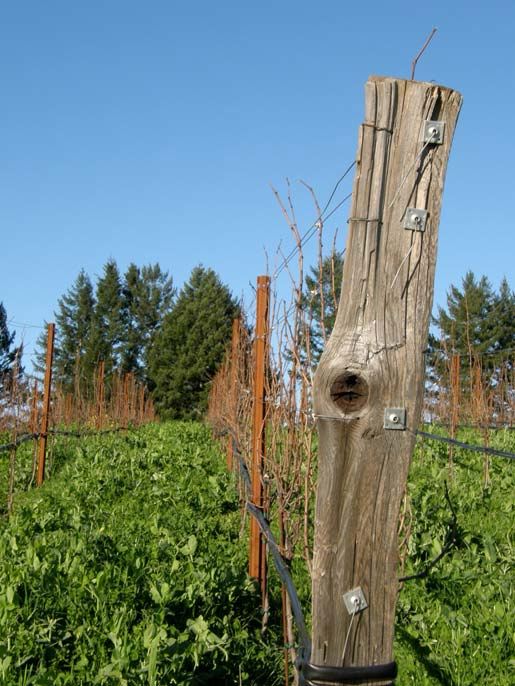
Pinot Briefs
 2006 DRC Wines For those of you who read John Kapon’s ‘Vintage Tastings,’ you know he tastes many of the world’s greatest Burgundies on a regular basis. He recently reported on a tasting of the 2006 DRC portfolio of wines held for the media and trade in New York City. The 2006 vintage has been overshadowed by the great 2005 vintage in Burgundy, but many connoisseurs are endearing themselves to the 2006 wines. At DRC the grapes were as ripe as in 2005. In the words of Aubert de Villaine, “If one can speak of a striking general character of this vintage, it is, indeed, purity: purity of aromas, purity of taste, purity of general expression, all in contrast to 2005 which was a bright, spectacular and symphonic vintage. In 2006 we hear chamber music with more discreet notes, but subtle and complex.” According to Kapon, at this early stage, 2006 was an “underdog” year for DRC with Echezeaux showing up the Grands Echezeaux, Romanee St. Vivant topping the Richebourg, and the La Tache out-muscling the Romanee-Conti.
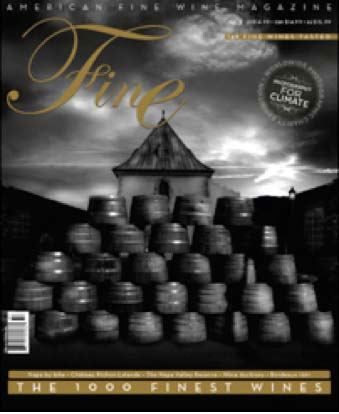 Fine - American Fine Wine Magazine This glossy, beautifully photographed and well written magazine debuted in 2008. Each quarterly issue is over 140 pages filled with fascinating stories about the world’s greatest wines and wine personalities with tasting notes exclusively of fine and rare wines. The editors are wine professionals who open and enjoy the most rare and valuable bottles on a daily basis - the only wine magazine to do so. The accumulated experience of the staff includes more than 60,000 fine wines from over 200 vintages. The tasting notes give highly useful, fresh information about the condition and optimum drinking window of the wines. The wines are rated as the readers would experience them, with labels proudly displayed, in good company and pleasant surroundings. Scores (on a 100 point scale) are based on how the wine is drinking currently, not its future potential. This magazine represents a fresh new approach to reviewing wine featuring a new generation of wine writers. Highly recommended. The magazine is available from large book retailers in this country or by subscribing through www.fine-magazines.com. New Producers from Bien Nacido Vineyard Their are two new additions to the Bien Nacido family beginning with the 2008 vintage, Twomey (Russian River Valley) and Jonata (Sta. Rita Hills). Wine & Spirits magazine has named Bien Nacido Vineyards’ vineyard manager, Chris Hammell, “Grower of the Year.” WillaKenzie Estate is Oregon’s First LIVE Winery WillaKenzie Estate announced this month that it is the first winery to receive the new Low Input Viticulture and Enology (LIVE) winery certification and the first to be awarded Oregon Certified Sustainable Wine (OCSW) for all of its 2008 vintage wines. LIVE has been certifying Oregon’s sustainable vineyards and individual wines since 1997. In 2008, LIVE created a similar certification process for entire winery facilities with stringent standards that mirror the same principles of its vineyard certification, but address sustainability inside the winery, including winemaking practices, facility energy use, responsible water usage, recycling and worker health and safety concerns. In 2009, the Oregon Wine Board awarded its first Oregon Certified Sustainable Wine (OCSW) designation, which included all 2008 vintage wines from WillaKenzie Estate. The OCSW certification logo will appear on bottles of WillaKenzie Estate 2008 wines. Grim Scenes in Australia’s Wine Country Australia’s worst wildfire disaster recently ravaged the countryside leaving thousands homeless and burning 850 square miles of land. In addition, winegrowers have been rocked by record heat. David Lloyd writes me from the Mornington Peninsula that southeast Australia lost 600k to 800k tons of fruit in the heat. Pinot Noir growers have been hard hit. At David’s Eldridge Estate, which is one of the coolest sites on the Mornington Peninsula, both 115 and 777 have shown damage and in some places there is 60+% loss. Growers in the Yarra and Macedon were hard hit as well.
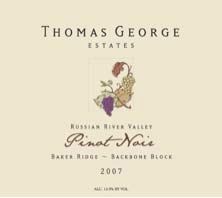 Thomas George Estates Opens After months of redesigning and updating the former home of Davis Bynum Winery on Westside Road in the Russian River Valley, Thomas George Estates is now open to the public. Visit the tasting room daily from 11:00 to 5:00 PM. 707-431-8031. The new website is www.thomasgeorgeestates.com.
Pinot Summit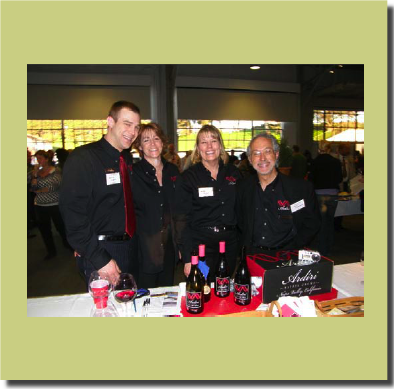 The 7th Annual Pinot Noir Summit will be held on Sunday, April 5, 2009, in San Rafael, California. The Summit is a culmination of the Pinot Noir Shootout which is a focused tasting of 272 Pinot Noirs from around the globe. This comprehensive tasting uses a diverse panel of experts who taste just 32 wines per day, allowing the judges to be completely immersed, focused and fair to the wines. The Shootout also explores the preferences of women versus men. The wines are tasted blind without reference to appellation, vintage or price. Attendees to The Summit taste the top 40 wines blind and can compare their findings to the panel’s choices. This is the only event in which the judges’ conclusions are put to the test by an unbiased panel of wine lovers. The Summit also includes workshops. I will be moderating a panel of newer Pinot Noir producers titled, “Discovering New Pinot Stars.” The four participating wineries are LionHeart, Seawind, Pleasant Valley Vineyards, and Jim Ball Vineyards. The event is limited to 250 pinotphiles and costs $100 per person plus tax. For information and to register online, visit www.affairsofthevine.com or call 707-874-1975.
Pinot Paradise

This 5th annual celebration of Pinot Noir in the Santa Cruz Mountains will be held Saturday and Sunday, March
28 and 29, 2009. On Saturday, the Pinot Pathways event consists of self-guided tours of Santa Cruz
Mountains Pinot Noir producing wineries, many of which are open only for this event. Held from 11:00 AM to
5:00 PM, the cost is $25 and Pathway tickets may be obtained at any one of the participating wineries on the
day of the event. Participating wineries include: Alfaro Family Vineyards, Bargetto Winery, Beauregard
Vineyards, Big Basin Vineyards, Burrell School Vineyards, Byington Vineyards & Winery, Domenico Wines,
Hallcrest Vineyards & Winery, Hunter Hill Vineyards & Winery, Loma Prieta Winery, Nicholson Vineyards,
Pleasant Valley Vineyards, Roudon-Smith Winery, Santa Cruz Mountains Vineyard, Sarah’s Vineyard, Silver
Mountain Vineyard, Sonnet Wines, Soquel Vineyards, Storrs Winery & Vineyards, Thomas Fogerty Winery,
Windy Oaks Vineyards & Winery and Wines of Vine Hill. On Sunday, the Grand Cruz event in the Villa Ragusa
ballroom in downtown Campbell will feature over 30 wineries pouring Pinot Noir accompanied by artisan
gourmet foods from a dozen Santa Cruz area restaurants. The live auction features double magnums from
each winery and a 5-liter blend of all the best Pinot Noirs being poured at the event. Tickets are $55 per
person in advance or $75 per person for a VIP Grand Cruz Tasting which includes a preliminary sub-regional
tour with the winemakers before the tasting. Additionally, Sunday morning technical sessions will include a
seminar exploring the newly designated six sub-regions of the Santa Cruz Mountains. I will be attending this
intimate event and hope to see members of the Crew there. For information, visit www.scma.com. Listen to Mary Lindsay, President of the Viticulture Association of the Santa Cruz Mountains, discuss this upcoming event: “Mary Lindsay Interview” |